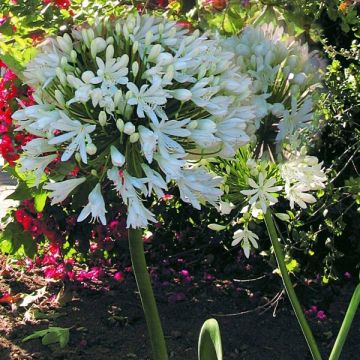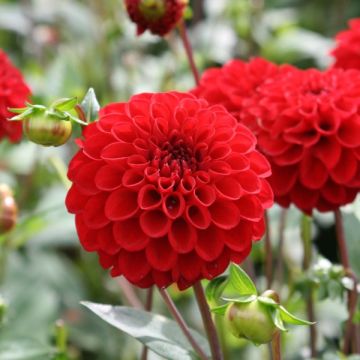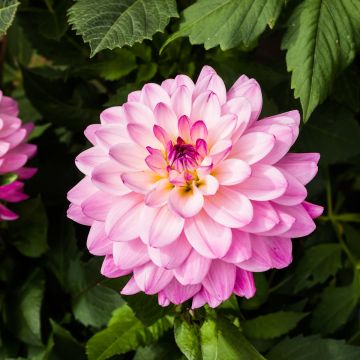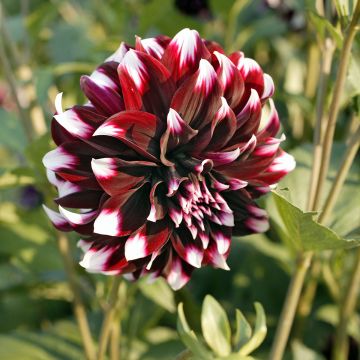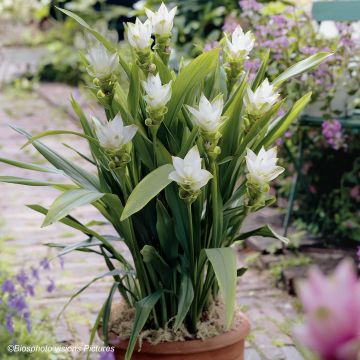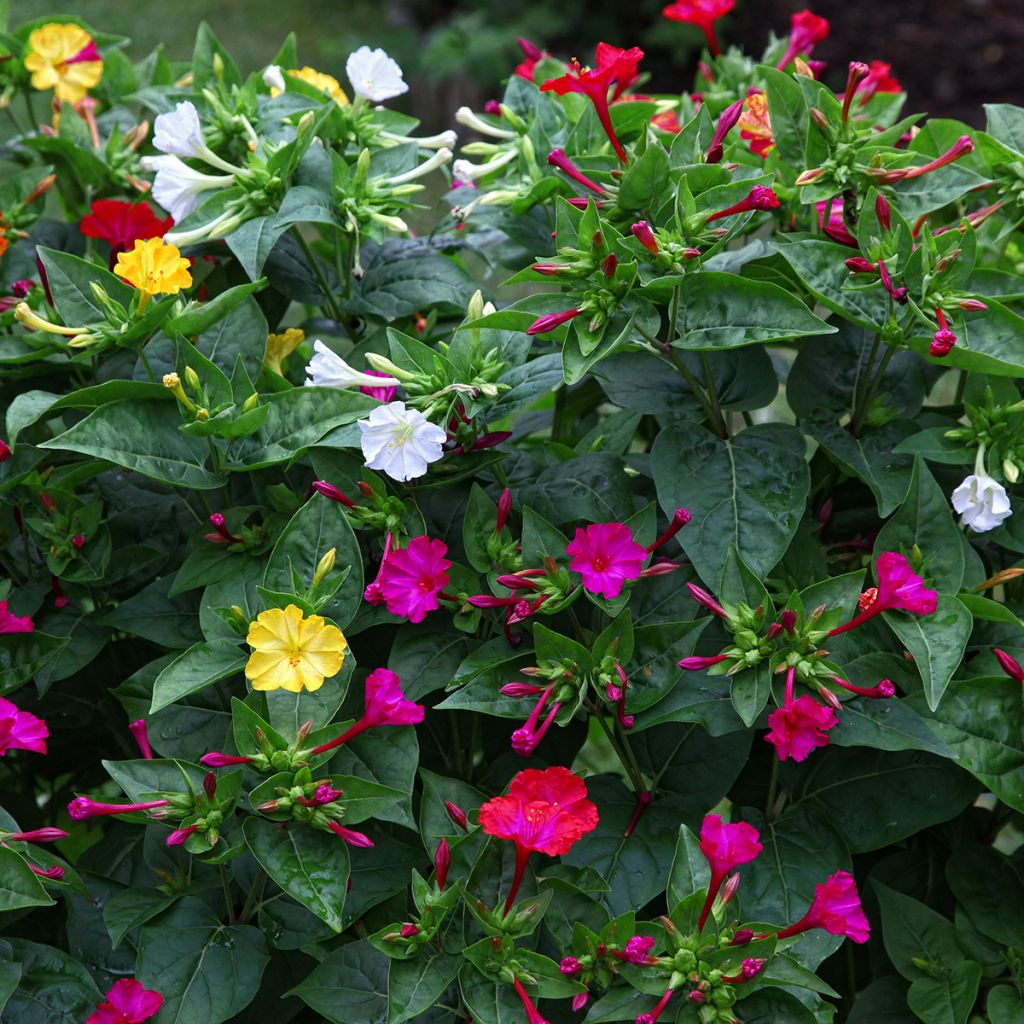

Mirabilis jalapa
Mirabilis jalapa
Mirabilis jalapa
Four o'clock flower, Marvel of Peru
Beautiful tubers resembling black radish. Plant upon receipt. Waiting for growth and the next fragrant bloom.
Nathalie, 11/04/2021
This item cannot be shipped to the selected country
Delivery charge from €5.90
More information
Schedule delivery date,
and select date in basket
This plant carries a 6 months recovery warranty
More information
We guarantee the quality of our plants for a full growing cycle, and will replace at our expense any plant that fails to recover under normal climatic and planting conditions.
From €5.90 for pickup delivery and €6.90 for home delivery
Express home delivery from €8.90.

Does this plant fit my garden?
Set up your Plantfit profile →
Description
The Four O'Clock Flower, known as Mirabilis Jalapa in Latin, grows rapidly from a black root that resembles a salsify. In the span of one season, the plant forms a lovely bush that blooms from July to October. This mix consists of several varieties with various colours. The flowers of the Four O'Clock Flower, pleasantly fragrant in the evening, open in cloudy weather or in the late afternoon. They are tender perennials, but easy to grow, and are often treated as annuals outside of mild regions. A semi-shaded or even shaded exposure allows you to enjoy the flowers even during the day. Create beautiful flower pots with these Marvels of Peru! Sold in packs of 10 bulbs in various colours.
Mirabilis jalapa, or Marvel of Peru, is a herbaceous perennial plant in the family Nyctaginaceae, native to dry tropical regions of Central and South America, such as Guatemala, Mexico, Chile, and Peru. It develops a large tuberous black root, which has traditional medicinal uses in various regions of the world.
The Four O'Clock Flower is a herbaceous perennial plant that reaches a height of 70-80cm (28-32in), sometimes more, and occupies a ground area of 40 to 60cm (16 to 24in). It is not very hardy, but its rapid growth allows it to be cultivated as an annual. Under our climates, it disappears in winter, blooms from June to October, but in the tropics, it is perennial and blooms all year round. The funnel-shaped flowers come in different colours including pink, red, yellow, and white. The flowers open in the evening and close the next day when the sun hits them. They emit a sweet fragrance from dusk until the middle of the night. This particular characteristic gave the plant its name Four O'Clock Flower: its fragrant flowers have fluorescent pigments that create patterns on the corolla and attract pollinating sphinx moths. The black fruit appears at the base of the flower once it has fallen. The dichotomous stems are solid, quadrangular, fleshy, green to reddish, thickened at the nodes, and bear opposite ovate or slightly cordate leaves, bright green, lighter on limestone soil and in full sun.
You will plant the Four O'Clock Flower roots upright, with the top covered by 7cm (3in). They are used in flower beds, at the base of east-facing walls, along a path, or near a porch, to be able to enjoy the flowers. They are quite difficult to combine, so they are most often planted in groups to create multicoloured flower beds that bloom for four months. They also grow very well in large, deep pots, taking care of watering and fertilizing. In mild areas, especially by the coast, you can leave the bulbs in the ground. The Four O'Clock Flower can be grown like a dahlia, and its tuber can be overwintered frost-free in a sandy mix.
Report an error about the product description
Plant habit
Flowering
Foliage
Botanical data
Mirabilis
jalapa
Nyctaginaceae
Four o'clock flower, Marvel of Peru
South America
Other Summer bulbs A to Z
Planting and care
The Four o'clock flower is an easy plant to grow, provided it is given a sheltered position away from strong winds, sunny or partly shaded, especially if you are growing it in a region where summers are hot. In the sun, the plant will be more floriferous, but the flowers will stay open longer on a plant that is slightly shaded in the afternoon. Under these conditions, it grows very rapidly.
It prefers to grow in light, humus-rich and well-drained soils that stay moist in summer and are close to neutral pH. The more fertile the soil, the more the plant will show significant development.
Growing it in a pot is perfectly possible with a mix of 80% potting soil and 20% garden soil in a deep container.
It is sensitive to overwatering. In regions with cold winters, it should be dug up and the root should be stored frost-free, just like Cannas or dahlias.
Planting period
Intended location
Care
-
, onOrder confirmed
Reply from on Promesse de fleurs
Haven't found what you were looking for?
Hardiness is the lowest winter temperature a plant can endure without suffering serious damage or even dying. However, hardiness is affected by location (a sheltered area, such as a patio), protection (winter cover) and soil type (hardiness is improved by well-drained soil).

Photo Sharing Terms & Conditions
In order to encourage gardeners to interact and share their experiences, Promesse de fleurs offers various media enabling content to be uploaded onto its Site - in particular via the ‘Photo sharing’ module.
The User agrees to refrain from:
- Posting any content that is illegal, prejudicial, insulting, racist, inciteful to hatred, revisionist, contrary to public decency, that infringes on privacy or on the privacy rights of third parties, in particular the publicity rights of persons and goods, intellectual property rights, or the right to privacy.
- Submitting content on behalf of a third party;
- Impersonate the identity of a third party and/or publish any personal information about a third party;
In general, the User undertakes to refrain from any unethical behaviour.
All Content (in particular text, comments, files, images, photos, videos, creative works, etc.), which may be subject to property or intellectual property rights, image or other private rights, shall remain the property of the User, subject to the limited rights granted by the terms of the licence granted by Promesse de fleurs as stated below. Users are at liberty to publish or not to publish such Content on the Site, notably via the ‘Photo Sharing’ facility, and accept that this Content shall be made public and freely accessible, notably on the Internet.
Users further acknowledge, undertake to have ,and guarantee that they hold all necessary rights and permissions to publish such material on the Site, in particular with regard to the legislation in force pertaining to any privacy, property, intellectual property, image, or contractual rights, or rights of any other nature. By publishing such Content on the Site, Users acknowledge accepting full liability as publishers of the Content within the meaning of the law, and grant Promesse de fleurs, free of charge, an inclusive, worldwide licence for the said Content for the entire duration of its publication, including all reproduction, representation, up/downloading, displaying, performing, transmission, and storage rights.
Users also grant permission for their name to be linked to the Content and accept that this link may not always be made available.
By engaging in posting material, Users consent to their Content becoming automatically accessible on the Internet, in particular on other sites and/or blogs and/or web pages of the Promesse de fleurs site, including in particular social pages and the Promesse de fleurs catalogue.
Users may secure the removal of entrusted content free of charge by issuing a simple request via our contact form.
The flowering period indicated on our website applies to countries and regions located in USDA zone 8 (France, the United Kingdom, Ireland, the Netherlands, etc.)
It will vary according to where you live:
- In zones 9 to 10 (Italy, Spain, Greece, etc.), flowering will occur about 2 to 4 weeks earlier.
- In zones 6 to 7 (Germany, Poland, Slovenia, and lower mountainous regions), flowering will be delayed by 2 to 3 weeks.
- In zone 5 (Central Europe, Scandinavia), blooming will be delayed by 3 to 5 weeks.
In temperate climates, pruning of spring-flowering shrubs (forsythia, spireas, etc.) should be done just after flowering.
Pruning of summer-flowering shrubs (Indian Lilac, Perovskia, etc.) can be done in winter or spring.
In cold regions as well as with frost-sensitive plants, avoid pruning too early when severe frosts may still occur.
The planting period indicated on our website applies to countries and regions located in USDA zone 8 (France, United Kingdom, Ireland, Netherlands).
It will vary according to where you live:
- In Mediterranean zones (Marseille, Madrid, Milan, etc.), autumn and winter are the best planting periods.
- In continental zones (Strasbourg, Munich, Vienna, etc.), delay planting by 2 to 3 weeks in spring and bring it forward by 2 to 4 weeks in autumn.
- In mountainous regions (the Alps, Pyrenees, Carpathians, etc.), it is best to plant in late spring (May-June) or late summer (August-September).
The harvesting period indicated on our website applies to countries and regions in USDA zone 8 (France, England, Ireland, the Netherlands).
In colder areas (Scandinavia, Poland, Austria...) fruit and vegetable harvests are likely to be delayed by 3-4 weeks.
In warmer areas (Italy, Spain, Greece, etc.), harvesting will probably take place earlier, depending on weather conditions.
The sowing periods indicated on our website apply to countries and regions within USDA Zone 8 (France, UK, Ireland, Netherlands).
In colder areas (Scandinavia, Poland, Austria...), delay any outdoor sowing by 3-4 weeks, or sow under glass.
In warmer climes (Italy, Spain, Greece, etc.), bring outdoor sowing forward by a few weeks.

































